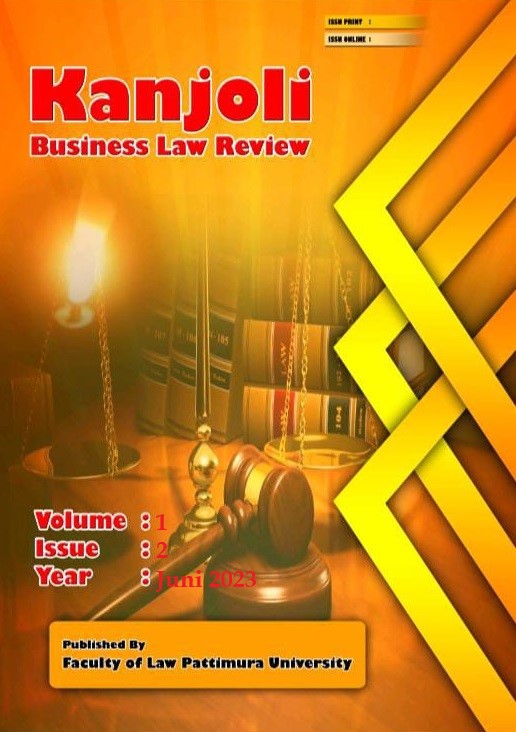Perlindungan Hukum Bagi Pencipta Yang Ciptaannya Digunakan Dalam Aplikasi Tiktok Menurut Undang Undang Nomor 28 Tahun 2014 Tentang Hak Cipta
Abstract
Tiktok is an application that is currently popular as a platform for creativity because it is filled with a selection of songs or music that can be created in the form of fragments of a few seconds to some in the form of full music, which is a copyrighted work whose use must be with the permission of the creator. The existence of the Tiktok application that uses songs belonging to the creator without permission can be said to have violated copyright, so the creator needs to get legal protection because if this is allowed it will harm the creator and the state. The research method used is normative juridical by using the approach of law number 28 of 2014 on copyright, conceptual approach and case approach. The results showed that creators who create works that are then used in the Tiktok application must have legal protection under the Copyright Law in Indonesia.
Downloads
References
Agis Dwi Prakoso, Penggunaan Aplikasi Tik Tok Dan Efeknya Terhadap Perilaku Keagamaan Remaja Islam Di Kelurahan Waydadi Baru Kecamatan Sukarame, Skripsi, UIN Raden Bintang Lampung, 2020.
Edward James Sinaga, Pengelolaan Royalti Atas Pengumuman Karya Cipta Lagu dan/atau Musik, Jurnal Ilmiah Kebijakan Hukum Volume 13 Nomor 3, 2020.
Habi Kusno, Perlindungan Hukum Hak Cipta Terhadap Pencipta Lagu Yang di Unduh Melalui Internet, Jurnal Fiat Iustitia Volume 10 Nomor 3, 2016.
Hozumi, T, Asian Copyright Handbook Indonesian Version, Ikatan Penerbit Indonesia, Jakarta, 2006.
https://repository.ump.ac.id/13208/3/Nanda%20Pratama%20Subagja%20BAB%202.pdf diakses pada tanggal 01 Juli 2023.
https://arek.its.ac.id/hmsi/2021/09/08/tiktok-aplikasi-yang-mengubah-dunia-sosial-media/ diakses pada tanggal 01 Juli 2023.
https://idmetafora.com/news/read/1353/Mengenal-Apa-Itu-TikTok-Sejarah-dan-Beberapa-Fitur-fiturnya.html diakses pada tanggal 01 Juli 2023.
https://dailysocial.id/post/apa-itu-tik-tok diakses pada tanggal 01 juli 2023.
https://www.liputan6.com/tekno/read/4464417/tiktok-digugat-rp-131-miliar-terkait-dugaan-pelanggaran-hak-cipta-lagu-virgoun diakses pada tanggal 01 juli 2023.
https://ameera.republika.co.id/berita/r8h478414/tiktok-pastikan-tidak-ada-pelanggaran-hak-ciptahak-kekayaan-intelektual-musisi#:~:text=REPUBLIKA.CO.ID%2C%20JAKARTA,konten%20kreator%20dan%20juga%20pengguna. Diakses pada tanggal 01 juli 2023.
https://smartlegal.id/hki/hak-cipta/2022/05/11/creator-tiktok-udah-tahu-ketentuan-hak-cipta-ini-belum/ diakses pada tanggal 1 juli 2023.
Joven Andis Hamdani, Perlindungan Hukum Hak Cipta Lagu Terhadap Pelanggaran Melalui Download Pada Website Penyedia Lagu Gratis, Fiat Iustitia Jurnal Hukum Volume 3 Nomor 1, 2022
Nabila Nasution, Analisi Hukum Pelanggaran Hak Cipta Pengguna Aplikasi Tiktok Ditinjau Dari UU Hak Cipta Nomor 28 Tahun 2014 Tentang Hak Cipta, Universitas Sumatera Utara, volume 14 , Medan 2021.
Peter Mahmud Marzuki, 2014. Penelitian Hukum Edisi Revisi, Jakarta Kencana.
Rory Jeff Akyuwen dan Wijaya Natalia Panjaitan, Perlindungan Hukum Bagi Pencipta Atau Pemegang Hak Cipta Yang Ciptaannya Digunakan Sebagai Ringtone, Tatohi, Jurnal Ilmu Hukum, Volume 3 Nomor 4 Juni 2023, Ambon.
Copyright (c) 2023 Wijaya Natalia Panjaitan

This work is licensed under a Creative Commons Attribution-NonCommercial 4.0 International License.
Authors who publish their manuscripts in this Journal agree to the following conditions:
- The copyright in each article belongs to the author, as well as the right to patent.
- Authors are able to enter into separate, additional contractual arrangements for the non-exclusive distribution of the journal's published version of the work (e.g., post it to an institutional repository or publish it in a book), with an acknowledgment of its initial publication in this journal.
- Authors are permitted and encouraged to post their work online (e.g., in institutional repositories or on their website) prior to and during the submission process, as it can lead to productive exchanges, as well as earlier and greater citation of published work.
- Authors have the right to self-archiving of the article (Author Self-Archiving Policy)











